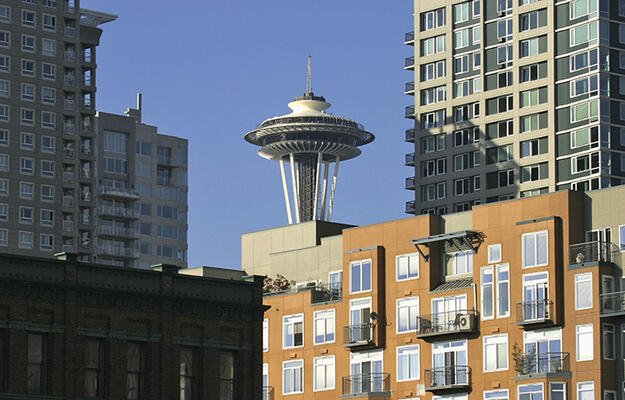
How Stable, Affordable Housing Can Help Tackle Food Insecurity
by Kimberly Burrowes
Farmers’ markets, community gardens, and fruit stands provide local residents access to healthy, affordable food in many neighborhoods. In areas with fewer grocery stores, farmers’ markets can help close the food access gap. But they don’t serve every neighborhood, and today, one in eight Americans experiences food insecurity—and they’re primarily from low-income households and communities of color. Although physical and mental health, family structure, and economic hardship are all associated with food insecurity, housing stability is also a key factor.
In the 1970s and ’80s, Washington, DC, experienced a dramatic decrease in full-service grocery stores. As middle-income families moved out of the city and into the suburbs, so, too, did healthy and affordable food. Neighborhoods east of the Anacostia River, which are predominately Black and have some of the highest poverty rates in DC—experienced extensive neighborhood change and went from having more than a dozen options for groceries to only three options today. Farmers’ markets and urban agriculture have been fundamental in filling the gap and enabling residents’ access to fresh and affordable food.
Choosing between housing and food
There is an important connection between housing stability and food access. Families experiencing financial hardship may have little money left for food after paying their rent or mortgage, face eviction or homelessness (having nowhere to safely store or prepare healthy food), or live in disinvested neighborhoods where access to healthy, affordable food is less likely.
Several studies exploring homelessness demonstrate the link between a lack of shelter and the risk of food insecurity. Though cities attempt to address this issue by establishing food pantries, soup kitchens, and other charitable food outlets, the relief is not sufficient or sustainable for the range of families living in unstable conditions.
A report commissioned by Feeding America (PDF) shows that more than half of the 46.5 million clients that Feeding America serves make the difficult choice between paying for housing or food. This is even more evident when there is a decrease in income, such as job changes, job loss, or disability, and a lack of social services to fill the gap. Families grapple with meeting their immediate needs (food, transportation, child care) while risking falling behind on rent or mortgage payments.
Food insecurity is both an income challenge and a neighborhood challenge. Many low-income residents live in underinvested neighborhoods in need of revitalization, particularly places experiencing high amounts of vacancy and blight. When families lack mobility in and around a neighborhood, they end up living farther from good schools, health care providers, employment opportunities, and healthy, affordable food.
These factors are all connected. Having stable, affordable housing means families will have more income to spend on necessities like food. Therefore, policymakers need to provide holistic solutions to address the complex challenges families face in navigating how to spend their limited resources. A longitudinal study showed that families living in subsidized housing had lower odds of food insecurity than those on a waiting list for such housing. Safe, decent, stable housing can be pivotal in the fight for increased food access. Implementing an inclusive policy approach for developing more affordable housing may be a good lever for also addressing food insecurity for many families.
Hence, your community—and the condition of your community—affects access to healthy food.
Housing authorities and policymakers can help
Research establishes a clear role for housing in providing access to food and helping families set aside a larger budget for food. The Family Options Study shows that providing any type of housing can begin to curb the level of food insecurity a family faces. But those who received permanent housing subsidies had the most dramatic improvements to their well-being, even without wraparound support services. This is why in neighborhoods like Anacostia, the solutions for reducing hardship should tackle housing instability and food insecurity jointly. Housing authorities can be important in bridging access to food through their programming for residents.
Bringing the food to the neighborhood is key. Housing organizations and community groups have played an important role by working with the most vulnerable residents to ensure they have access to healthy affordable food. Housing authorities (PDF) have formed tenant-led community gardens to encourage urban agriculture in food deserts. In a targeted initiative, the Good Food Good Medicine program provides cooking and food education classes in two low-income housing sites in Barre, Vermont. The program helps address the food insecurity gap for residents living in the Highgate and Green Acres apartments by using the spring and summer months to grow fruits and vegetables, the fall months for harvesting and preservation, and winter for health and wellness education. The program is also working on mapping where residents can go to access healthy, fresh food in their community. The housing sites collaborate with the food program to ensure residents’ needs are being comprehensively met.
The housing authority in Portland, Oregon, offers a few ways to help residents living in affordable housing units address challenges accessing food. The New Columbia community recognized that school lunch programs were not adequate and teens were concerned with the stigma around seeking food assistance. To combat this issue, the housing authority, with the help of other local community partners and the Urban Institute, launched a pilot program to offer monthly fresh food distribution and a food literacy course for teens. There have also been similar programs in Chicago, where the housing authority played an active role connecting residents to healthy food options by hosting summer food sites in and around their developments.
Housing policymakers can call for strengthening social safety net services to reduce upstream factors that impact housing instability. The Gus Schumacher Nutrition Incentive Program is a large initiative coming out of the 2018 Farm Bill that encourages entities to apply for USDA grants to fund these cross-sector needs. This has allowed SNAP benefits to cover more farmers’ markets and mobile markets in some cities (PDF). As cities such as Austin, New York, and Washington, DC, double SNAP benefits, this policy change could grant households greater flexibility to also alleviate housing expenditures and provide housing authorities more latitude to support families in this process.
Tackling food insecurity can mitigate some of the compounding factors that create housing instability, but not all of them. Places like Anacostia still face challenges encouraging economic development while retaining housing affordability, but improving access to healthy food can make each day a little easier for many low-income households.
Photo by Nejron Photo/Shutterstock


